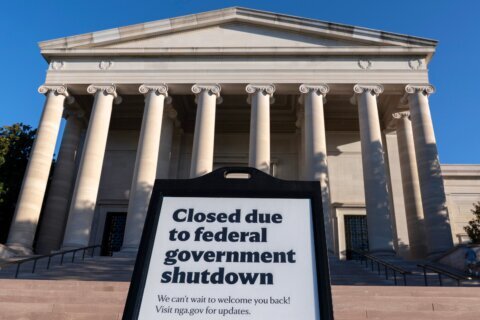With the ongoing lack of substantial rain, the streamflow of the Potomac River is so low that daily drought monitoring has been triggered for the area’s prime drinking water supply.
Starting Monday morning, the flow of the Potomac River dropped below 2,000 cubic feet per second at Point of Rocks, Maryland. Dropping below that threshold triggers daily drought monitoring by the Interstate Commission on the Potomac River Basin.
The U.S. Geological Survey gauge is near the bridge connecting Maryland’s Frederick County with Loudoun County, Virginia, and is located upstream from the Potomac River intakes for the Washington Aqueduct, WSSC Water and Fairfax Water.
ICPRB, the agency that implements coordination plans between the three local water supplies that rely upon the Potomac River, says there is a higher-than-normal chance that water will have to be released into the Potomac from upstream reservoirs later this year to meet drinking water demands.
“Currently, the water flow in the Potomac River is sufficient to meet the water demands of the Washington metropolitan area without requiring releases from upstream reservoirs,” said the ICPRB, in a June Water Supply Outlook.
ICPRB says there is a 19% to 34% probability that flow will drop below 600 to 700 million gallons per day at the Little Falls Dam water intake, which could require water supply releases from Little Seneca Reservoir, located in Black Hill Regional Park in Boyds, Maryland, or Jennings Randolph Lake, straddling Maryland and West Virginia.
“In May, precipitation in the Potomac basin was 2.4 inches below normal, with a cumulative deficit of 6.5 inches for the past 12 months, as of May 31,” according to the report. “The latest update from the Middle Atlantic River Forecast Center suggests no significant indications of heavy rainfall in the coming weeks, signaling a continuation of dry conditions in most areas.”
In the event that reservoir water were released from Little Seneca, it would take approximately one day to reach downstream intakes for Fairfax Water, WSSC Water and the Washington Aqueduct. Water from the much larger Jennings Randolph Lake would take nine days to reach the local drinking water intakes.
Backup drinking water storage, supply still unclear
The Potomac River is the sole water supply for the District, Arlington County and Falls Church, and the primary water supply for two other local water utilities.
WSSC Water, which serves most of Montgomery and Prince George’s counties, draws 30% of the water it sends to customers from the Patuxent River. Fairfax Water, which serves Fairfax and Prince William counties, gets a portion of its water from the Occoquan Reservoir.
In December 2022, D.C. Del. Eleanor Holmes Norton successfully spearheaded the effort to authorize the U.S. Army Corps of Engineers to conduct studies to find a secondary drinking water source and additional drinking water storage. However, funding has not been secured to pay for the study.
In March of this year, ICPRB Executive Director Michael Nardolilli and Norton reminded Congress of the 30 year anniversary of the Colonial Pipeline rupture in Reston, Virginia, which forced Fairfax Water to shut down its drinking water intakes on the Potomac River for two weeks because of the spill.
“We were fortunate that only one of the water supplier intakes had to be shut down, but that was a wake-up call that we need to build into our system more resiliency, to have supplemental storage or a backup water supply,” Nardolilli told WTOP in March.
It’s been more than a decade since Fairfax Water, WSSC Water and the Washington Aqueduct have had to supplement the flow of the Potomac. The most recent releases were in 2010, 2002 and 1999.
Editor’s note: Drought monitoring is done on daily, rather than hourly basis.








